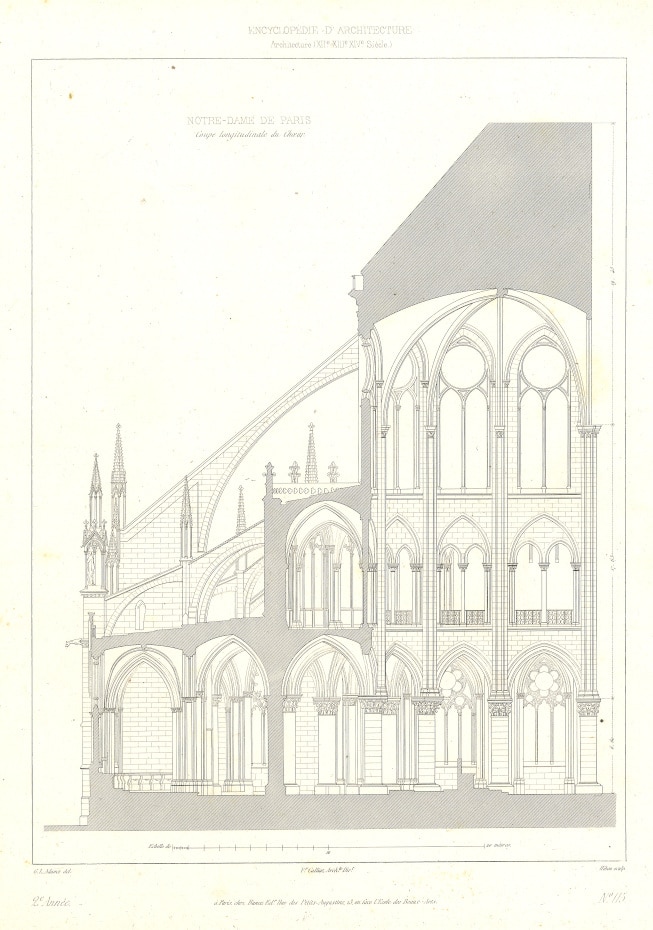Middle Ages Construction
In the Middle Ages, Notre Dame Cathedral architects are rarely mentioned and are known instead as a mason or “master builder”. The name of Notre-Dame Cathedral’s first architect is unknown. In the cathedral’s second building phase, from the mid-13th to mid-14th centuries, the master masons are identified as Jean de Chelles, Pierre de Montreuil and Pierre de Chelles.
Jean de Chelles (1200-1258)
Jean de Chelles, also known as Jehan de Chelles, is identified as Notre-Dame Cathedral’s master builder thanks to an inscription in the south transept which commemorates his role after his death in 1258. He oversaw the construction of the north transept, the design and start of the construction of the south side adorned with the Saint-Etienne portal. He also introduced a new architectural concept based on large bay windows pierced into the walls. This technique was successfully used in 1231 at the Saint-Denis basilica by the “master of Saint Denis”, which perhaps may be Jean de Chelles himself.
Pierre de Montreuil (1200-1267)
Prior to his work on Notre-Dame Cathedral, Pierre de Montreuil took part in the greatest construction sites of his time: the abbey of Saint-Germain-des-Prés in 1239 and the Saint-Denis basilica around 1247. When he succeeded Jean de Chelles on the Notre-Dame site, he was famous for his innovative approaches to construction. His contribution to the cathedral is major: he erected the large round pillars that support the fallout ribs. This means that the architecture extends directly from the ground to the vaults without interruption. He also enlarged the nave and aisles, and modified the vaults and nave of the choir. On Notre-Dame Cathedral’s exterior, he worked on the apse, the arms of the transept, the braces and the south portal. He had the triforium, the interior gallery that opens onto the nave from above the side aisles, adorned with stained glass. Thanks to Pierre de Montreuil, we have the emergence of Notre-Dame’s Gothic style. In 1265, he was named master of works of the cathedral of Paris, and two years later after his death he was referred to as doctor lathomorum, or “master of built stone”.
Pierre de Chelles
Pierre de Chelles, who was the son or nephew of Jean de Chelles, took over the Notre-Dame de Paris construction project from Pierre de Montreuil. His involvement begins around 1296 with the chapels of the apse. He then worked on the flying buttresses above the apse. He worked from 1300 to 1318 on the construction of the rood screen (an ornate partition between the chancel and nave) and its sculpted decoration at the end of the choir. When he died, other architects finalized his work, notably Jean Ravy from 1318 to 1344 and then Jean Le Bouteiller.
19th Century Renovation
The next Notre Dame Cathedral architects to make their mark on Notre-Dame Cathedral in the mid-19th century are Jean-Baptiste Lassus and, most notably, Eugène Viollet-le-Duc.
Jean-Baptiste Lassus (1807-1857)
Jean-Baptiste Lassus was a French architect who became an expert in restoration or recreation of medieval architecture. He was an active conservator, working in the Diocese of Paris, Le Mans and Chartres. He worked on the restoration of Sainte-Chapelle in Paris, a project where he trained the young Eugène Viollet-le-Duc. From 1844, he collaborated with Viollet-le-Duc on the restoration of Notre-Dame Cathedral, a project that Viollet-le-Duc continued on his own after Lassus’ death from liver disease in 1857.
Eugène-Emmanuel Viollet-le-Duc (1814 –1879)
Eugène Viollet-le-Duc was an architect and author who restored many prominent medieval landmarks in France, including those which had been damaged or abandoned during the French Revolution. At age 26 he led the restoration of Vézelay Abbey and he was in his thirties when he won the competition for the restoration of Notre-Dame Cathedral with Jean-Baptiste Lassus. When submitting their project, Lassus and Viollet-le-Duc proposed a moral charter to demonstrate “religious discretion” and “complete abnegation”.
Notre-Dame Cathedral was the most important restoration project of that time. It took place from 1844 to 1864, with a break between 1851 and 1859, due to lack of financial resources. During this time, Viollet-le-Duc’s notoriety grew, as did criticisms of his work. In the course of his work, he was confronted with the dilemma to find the cathedral’s original medieval state or to keep the traces of history. He often adopts compromises or interprets the original architecture with additions in the medieval style. His contemporaries reproached him for it.
Viollet-le-Duc approached the repair of the cathedral in a modern and unique way. He based his work on a body of documents made up of old drawings. He methodically studied the monument, analyzing every detail to understand its articulations and modifications over time. He added to his knowledge of medieval construction materials and techniques, and asked craftsmen to set up their workshops at the foot of the cathedral. He collected his observation in his Dictionary of French Architecture from the 11th to 14th Century, in which he explains his philosophy of restoration. According to him, no architectural structure surpasses the beauty of Notre-Dame Cathedral.
